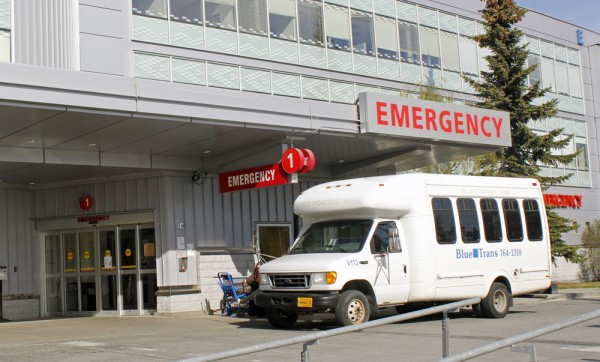
Two big hospitals in Anchorage have competing visions for how to expand access to emergency care. Alaska Regional wants to build two freestanding emergency departments on opposite ends of the city, while Providence is hoping to add rooms to specialize in pediatric emergencies on its campus. The decision will ultimately be made by the state health commissioner but the public can weigh in now.
On a busy day, the emergency department at Providence Hospital admits more than 200 patients. There aren’t enough rooms, so some patients are on beds in hallways, with curtains for privacy.
Dr. Daniel Safranek, the department’s medical director, says it’s not ideal.
“It makes the department feel crowded and a little bit chaotic,” Safranek said.
Providence is asking the state to approve 14 more emergency room beds. 10 will be focused on pediatric emergency patients, freeing up other beds for adults. Because of crowding in it’s current ER, Providence says most of those new rooms could be filled as soon as they’re built.
But in Alaska, hospitals need approval from the state to build big new projects. The idea is to prevent hospitals from building too many facilities and then passing the cost onto consumers. The state has decided Anchorage can support 13 new emergency room beds between now and 2022. And Alaska Regional Hospital has it’s own vision of how to best use those beds. CEO Julie Taylor wants to build the first freestanding emergency departments in Alaska, one in South Anchorage and another in Eagle River.
“It’s a model that’s proven in other markets to be more efficient and more effective and also can save lives,” Taylor said.
Freestanding emergency departments offer a higher level of care than urgent care clinics. They operate 24 hours a day, are staffed with emergency medicine physicians and are equipped with cat scans and x-ray machines. Taylor says residents who live in the outlying areas of Anchorage deserve quicker access to emergency care.
“We are at a disadvantage because all of the hospitals are located in a two mile radius of each other,” Taylor said. “So what if we had an earthquake? All the sudden the roads were cut off, everything is in one central area.”
Because freestanding ER’s aren’t attached to a hospital though, they don’t allow access to specialists or surgery or blood transfusions. In the Lower 48, they have been criticized for increasing inappropriate emergency room use and driving up the cost of care. Taylor says that is not Alaska Regional’s intention.
Taylor says HCA, the company that owns Regional, will have 60 freestanding ER’s open in the rest of the country by the end of the year. Swedish, which is affiliated with Providence, opened two in western Washington before the hospitals completed their affiliation.
But Dr. Safranek, at Providence hospital, is skeptical the concept is right for Anchorage. He says many patients who visit freestanding ER’s would be better served in an urgent care clinic. And he says in a true emergency a patient is going to need to be transferred to a hospital.
“And more than likely when you’re transferred, you’re going to end up in the emergency department of that hospital, because that’s where you can get services quickly,” Safranek said. “So you end up delaying care for the sickest patients.”
Dr. Safranek doesn’t think freestanding ER’s deserve to be measured against traditional ER beds as Commissioner Valerie Davidson weighs her decision.
The state disagrees. And it will be up to the Office of Rate Review in the Division of Health and Social Services to make a recommendation to the commissioner, says Executive Director Jared Kosin.
“We’ll look at what the trend patterns are for access,” Kosin said. “And we’ll do our analysis and ultimately it will be up to the commissioner to listen to the public, look at the proposals and make a decision.”
Kosin says he expects Commissioner Davidson to issue a decision by the end of July. She could decide to split the ER beds between the two hospitals. A public hearing on the issue will be held next Monday May 18th from 4-7 pm at the Loussac Library.
This story is part of a partnership between APRN, NPR and Kaiser Health News.
Annie Feidt is the broadcast managing editor at Alaska Public Media. Reach her at afeidt@alaskapublic.org. Read more about Annie here.





